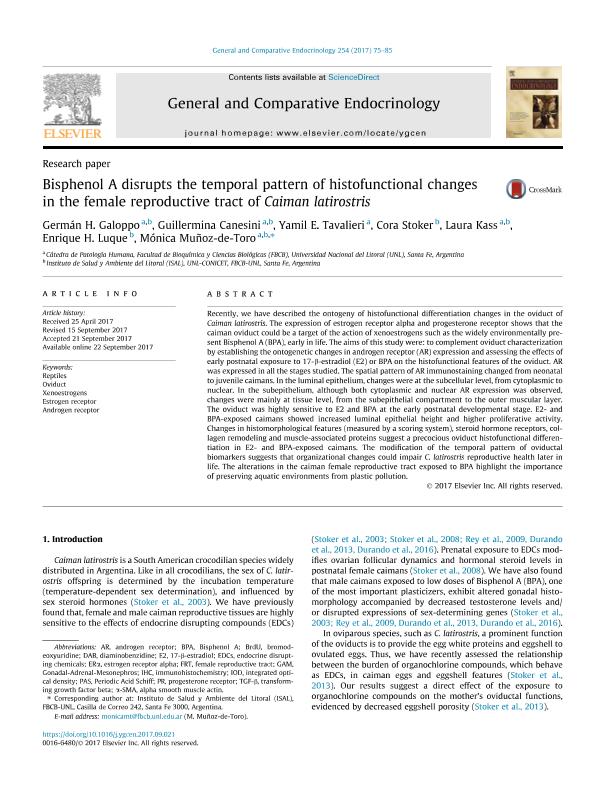Mostrar el registro sencillo del ítem
dc.contributor.author
Galoppo, Germán Hugo

dc.contributor.author
Canesini, Guillermina

dc.contributor.author
Tavalieri, Yamil Ezequiel

dc.contributor.author
Stoker, Cora

dc.contributor.author
Kass, Laura

dc.contributor.author
Luque, Enrique Hugo

dc.contributor.author
Muñoz de Toro, Monica Milagros

dc.date.available
2018-08-17T14:04:55Z
dc.date.issued
2017-12
dc.identifier.citation
Galoppo, Germán Hugo; Canesini, Guillermina; Tavalieri, Yamil Ezequiel; Stoker, Cora; Kass, Laura; et al.; Bisphenol A disrupts the temporal pattern of histofunctional changes in the female reproductive tract of Caiman latirostris; Academic Press Inc Elsevier Science; General and Comparative Endocrinology; 254; 12-2017; 75-85
dc.identifier.issn
0016-6480
dc.identifier.uri
http://hdl.handle.net/11336/56077
dc.description.abstract
Recently, we have described the ontogeny of histofunctional differentiation changes in the oviduct of Caiman latirostris. The expression of estrogen receptor alpha and progesterone receptor shows that the caiman oviduct could be a target of the action of xenoestrogens such as the widely environmentally present Bisphenol A (BPA), early in life. The aims of this study were: to complement oviduct characterization by establishing the ontogenetic changes in androgen receptor (AR) expression and assessing the effects of early postnatal exposure to 17-β-estradiol (E2) or BPA on the histofunctional features of the oviduct. AR was expressed in all the stages studied. The spatial pattern of AR immunostaining changed from neonatal to juvenile caimans. In the luminal epithelium, changes were at the subcellular level, from cytoplasmic to nuclear. In the subepithelium, although both cytoplasmic and nuclear AR expression was observed, changes were mainly at tissue level, from the subepithelial compartment to the outer muscular layer. The oviduct was highly sensitive to E2 and BPA at the early postnatal developmental stage. E2- and BPA-exposed caimans showed increased luminal epithelial height and higher proliferative activity. Changes in histomorphological features (measured by a scoring system), steroid hormone receptors, collagen remodeling and muscle-associated proteins suggest a precocious oviduct histofunctional differentiation in E2- and BPA-exposed caimans. The modification of the temporal pattern of oviductal biomarkers suggests that organizational changes could impair C. latirostris reproductive health later in life. The alterations in the caiman female reproductive tract exposed to BPA highlight the importance of preserving aquatic environments from plastic pollution.
dc.format
application/pdf
dc.language.iso
eng
dc.publisher
Academic Press Inc Elsevier Science

dc.rights
info:eu-repo/semantics/openAccess
dc.rights.uri
https://creativecommons.org/licenses/by-nc-sa/2.5/ar/
dc.subject
Androgen Receptor
dc.subject
Estrogen Receptor
dc.subject
Oviduct
dc.subject
Reptiles
dc.subject
Xenoestrogens
dc.subject.classification
Otras Ciencias Biológicas

dc.subject.classification
Ciencias Biológicas

dc.subject.classification
CIENCIAS NATURALES Y EXACTAS

dc.title
Bisphenol A disrupts the temporal pattern of histofunctional changes in the female reproductive tract of Caiman latirostris
dc.type
info:eu-repo/semantics/article
dc.type
info:ar-repo/semantics/artículo
dc.type
info:eu-repo/semantics/publishedVersion
dc.date.updated
2018-08-16T17:20:59Z
dc.journal.volume
254
dc.journal.pagination
75-85
dc.journal.pais
Países Bajos

dc.journal.ciudad
Amsterdam
dc.description.fil
Fil: Galoppo, Germán Hugo. Consejo Nacional de Investigaciones Científicas y Técnicas. Centro Científico Tecnológico Conicet - Santa Fe. Instituto de Salud y Ambiente del Litoral. Universidad Nacional del Litoral. Instituto de Salud y Ambiente del Litoral; Argentina. Universidad Nacional del Litoral. Facultad de Bioquímica y Ciencias Biológicas; Argentina
dc.description.fil
Fil: Canesini, Guillermina. Consejo Nacional de Investigaciones Científicas y Técnicas. Centro Científico Tecnológico Conicet - Santa Fe. Instituto de Salud y Ambiente del Litoral. Universidad Nacional del Litoral. Instituto de Salud y Ambiente del Litoral; Argentina. Universidad Nacional del Litoral. Facultad de Bioquímica y Ciencias Biológicas; Argentina
dc.description.fil
Fil: Tavalieri, Yamil Ezequiel. Universidad Nacional del Litoral. Facultad de Bioquímica y Ciencias Biológicas; Argentina
dc.description.fil
Fil: Stoker, Cora. Consejo Nacional de Investigaciones Científicas y Técnicas. Centro Científico Tecnológico Conicet - Santa Fe. Instituto de Salud y Ambiente del Litoral. Universidad Nacional del Litoral. Instituto de Salud y Ambiente del Litoral; Argentina
dc.description.fil
Fil: Kass, Laura. Consejo Nacional de Investigaciones Científicas y Técnicas. Centro Científico Tecnológico Conicet - Santa Fe. Instituto de Salud y Ambiente del Litoral. Universidad Nacional del Litoral. Instituto de Salud y Ambiente del Litoral; Argentina. Universidad Nacional del Litoral. Facultad de Bioquímica y Ciencias Biológicas; Argentina
dc.description.fil
Fil: Luque, Enrique Hugo. Consejo Nacional de Investigaciones Científicas y Técnicas. Centro Científico Tecnológico Conicet - Santa Fe. Instituto de Salud y Ambiente del Litoral. Universidad Nacional del Litoral. Instituto de Salud y Ambiente del Litoral; Argentina
dc.description.fil
Fil: Muñoz de Toro, Monica Milagros. Consejo Nacional de Investigaciones Científicas y Técnicas. Centro Científico Tecnológico Conicet - Santa Fe. Instituto de Salud y Ambiente del Litoral. Universidad Nacional del Litoral. Instituto de Salud y Ambiente del Litoral; Argentina. Universidad Nacional del Litoral. Facultad de Bioquímica y Ciencias Biológicas; Argentina
dc.journal.title
General and Comparative Endocrinology

dc.relation.alternativeid
info:eu-repo/semantics/altIdentifier/doi/https://dx.doi.org/10.1016/j.ygcen.2017.09.021
dc.relation.alternativeid
info:eu-repo/semantics/altIdentifier/url/https://www.sciencedirect.com/science/article/pii/S001664801730309X
Archivos asociados
